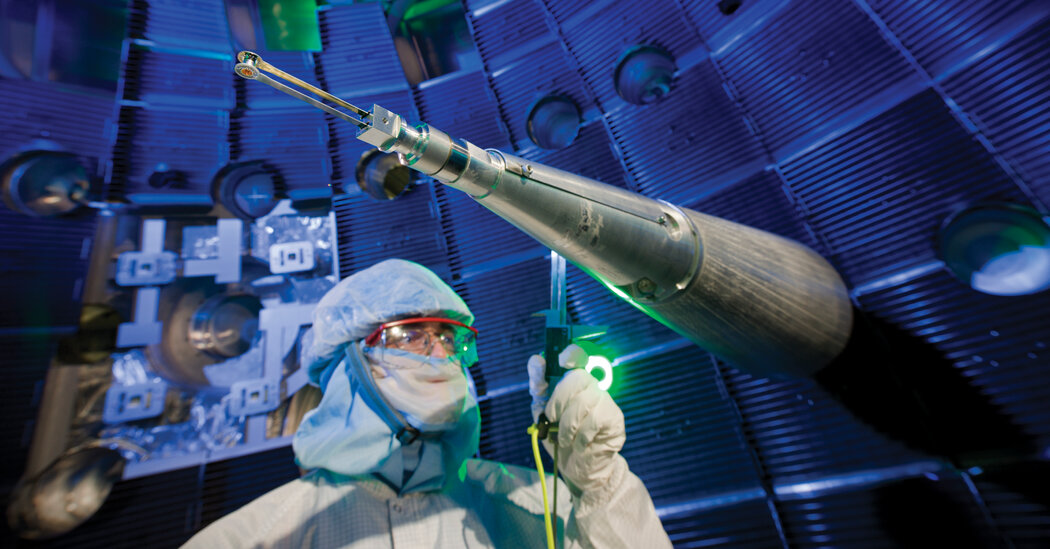The U.S. Division of Power is creating three analysis facilities in hopes of harnessing laser-based miniature thermonuclear explosions in future energy vegetation, officers introduced Thursday.
The three facilities – primarily based at Lawrence Livermore Nationwide Laboratory in California, Colorado State College, and the College of Rochester in New York State – will share a complete of $42 million over 4 years.
Analysis efforts will focus extra on the fundamental applied sciences wanted for any inertial fusion system, mentioned Scott Hsu, DOE’s lead fusion coordinator.
Combining two small atoms – normally hydrogen – right into a heavier atom produces power. This course of, generally known as fusion, is what powers the Solar and different stars. If managed fusion might be recreated on Earth, it might result in an considerable power supply that doesn’t generate planet-warming carbon dioxide or long-lived radioactive waste.
Most fusion power analysis so far, and a lot of the division’s fusion science funds, has centered on reactors that use robust magnetic fields to include super heated hydrogen till the nuclei collide and fuse. However a profitable experiment final yr on the Nationwide Ignition Facility (NIF) in Livermore highlighted a distinct method: capturing highly effective lasers at a single pellet of hydrogen, squeezing its atoms collectively to generate a flash of fusion.
The NIF was not designed as a prototype for fusion energy technology. It has been used primarily to assist keep US nuclear weapons since nuclear testing ceased in 1992.
The NIF science experiment fired a single laser pulse at a hydrogen gasoline pellet. A sensible energy plant would wish to fireside laser pulses repeatedly — at a cadence of maybe 10 per second — with a brand new gasoline pellet launched for every pulse.
These lasers should be extra highly effective, extra dependable, and extra power environment friendly than these at NIF. Hydrogen gasoline targets should be low-cost and simple to fabricate. One energy plant will want a relentless provide of tens of millions of pellets. New analysis facilities will assist tackle these obstacles.
The Power Division obtained many functions, and the overview panel chosen Livermore, Rochester and Colorado states, mentioned Kramer Ackley, who directs the federal government’s inertial fusion power science program. Every of the profitable proposals includes collaboration with different universities, nationwide laboratories and personal firms.
“You need to deliver the brightest individuals in your discipline collectively so you may innovate and tackle a few of the challenges of inertial fusion power,” Dr. Ackley mentioned.
One of many College of Rochester middle’s essential targets is to check a brand new laser fired instantly on hydrogen gasoline. This method is extra power environment friendly than that used within the NIF trial in Livermore. But when slight variations in laser mild generate instability, that thwarts fusion.
Instabilities could be tamed if the laser mild is unfold over a variety of wavelengths. Scientists on the College of Rochester have adopted this method, generally known as direct propulsion, for years, and the middle’s analysis funds will go towards experiments that take a look at whether or not the brand new high-energy laser can overcome this downside. “This actually opens up the direct driving path,” mentioned Dustin Frolla, the physicist who leads the Rochester middle.
The Colorado State Middle will examine a number of kinds of lasers proposed for numerous inertial fusion ideas, in addition to study completely different designs for propellant targets. Carmen Mignone, a professor {of electrical} and laptop engineering who led the middle’s proposal, mentioned she is going to look into new supplies for coatings utilized in laser optics to allow them to higher survive the fixed barrage of high-energy lasers.
Tami Ma, a plasma physicist who leads the Livermore Middle, mentioned its focus will broaden past the oblique propulsion method utilized by NIF and start to deal with what is required to construct an precise energy plant. “It isn’t simply that you’ve a goal, shoot it, and generate power,” Dr. Ma mentioned.
The $42 million — $16 million every for Livermore and the state of Colorado, and $10 million for the town of Rochester — is the primary of a collection of modest seed investments that will probably be made in laser fusion within the coming years. It represents a small slice of the Power Division’s fusion power sciences funds, which is spending greater than half a billion {dollars} this yr.
“These facilities are at present simply the seed of a US program,” Dr. Ma mentioned.
Preliminary analysis ought to assist make clear essentially the most promising approaches. “The funding just isn’t sufficient to totally get these solutions,” Dr. Ma mentioned. “However I feel on the finish of 4 years, we are able to chart a promising path ahead for the USA to exhibit a very large-scale pilot plant.”


Thanks so much with regard to giving me personally an update on this subject matter on your blog. Please be aware that if a fresh post appears or when any improvements occur with the current post, I would be interested in reading a lot more and knowing how to make good utilization of those methods you talk about. Thanks for your efforts and consideration of other individuals by making this site available.